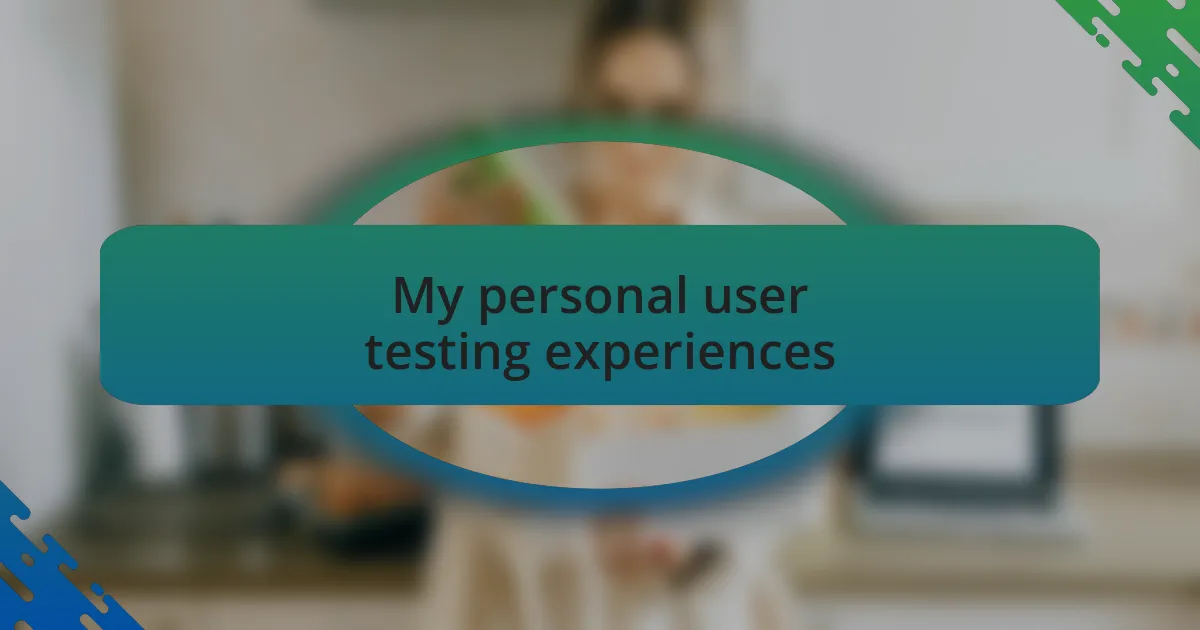Key takeaways:
- User testing reveals discrepancies between developer assumptions and actual user experiences, emphasizing the value of direct feedback.
- Methodologies like moderated testing and A/B testing provide real-time insights and data-driven results, influencing design decisions significantly.
- Tools like Lookback and Hotjar enhance the understanding of user interactions, highlighting areas needing improvement.
- Personal experiences underscore the necessity of visibility, emotional response, and performance in creating user-centric software solutions.

Importance of user testing processes
User testing processes are crucial because they bridge the gap between developers’ intentions and actual user experiences. I remember a project where our team thought we had created an intuitive interface, only to learn from user testing that most users struggled to navigate it. This humbling experience taught me that assumptions can be misleading; direct feedback is invaluable.
Moreover, incorporating user feedback early helps in identifying pain points that might not be obvious to developers. I once observed users as they interacted with a prototype, and it was eye-opening to see their hesitations and frustrations. Isn’t it fascinating how a simple observation can reveal so much about user behavior?
Finally, user testing fosters a culture of empathy within development teams. When I see real users engaging with our product, I can’t help but feel connected to them, understanding their needs on a deeper level. How can we truly create effective software without stepping into the users’ shoes? This empathetic approach not only enhances product quality but also leads to a more satisfying user experience.

Key methodologies in user testing
User testing methodologies can vary widely, and each has its strengths depending on the project’s goals. One method that has always resonated with me is moderated testing, where a facilitator guides users through tasks while asking questions. I remember leading a session where a user articulated their thoughts aloud; it provided real-time insights that would have been lost if they were simply filling out a survey afterward. How often do we get the chance to hear a user’s thought process directly?
Another effective approach is A/B testing, which allows you to compare two versions of a feature to see which performs better. In one project, we tested two different landing page designs. The version with a simpler layout led to a 30% increase in sign-ups! It was exhilarating to see data-driven choices deliver tangible results. Isn’t it incredible how small changes can have such profound impacts on user engagement?
Lastly, remote unmoderated testing has gained traction for its convenience and scalability. I once set up a test where participants completed tasks in their own environments. The results were eye-opening; users approached the product with fresh eyes, unencumbered by our preconceived notions. This method helped me appreciate the context in which users interact with software, as their unique environments often shape their experiences in unexpected ways. Don’t you think understanding these contexts is essential for crafting software that truly resonates?

Tools for effective user testing
When it comes to tools for effective user testing, I’ve always found that usability testing platforms play a crucial role. One tool I frequently use is Lookback, which allows for live video interactions with users as they navigate our software. I’ll never forget the time a user paused during a task to express confusion about a specific feature; their on-camera reaction was invaluable. Have you ever had that moment where feedback suddenly clarifies the direction of your entire project?
Another favorite of mine is Hotjar, which utilizes heatmaps to visually represent user interactions on a website. I remember analyzing a heatmap from a recent project and was surprised to see that users were clicking on parts of the page that I thought were purely decorative. It raised some important questions: Are we truly guiding users effectively? Are there hidden expectations we need to address? These insights can shift our design priorities dramatically.
Additionally, tools for survey-based feedback, like Typeform, can help gather user impressions after testing sessions. I once sent out a survey following a beta test, and the open-ended responses revealed preferences I hadn’t anticipated. Users shared their genuine feelings, which often pointed towards features I believed were already polished. Isn’t it fascinating how our assumptions can sometimes blind us to the actual user experience?

My personal user testing experiences
Throughout my user testing experiences, I’ve encountered moments that profoundly shaped my understanding of user behavior. There was a particular session where a user struggled to find a call-to-action button hidden within a crowded layout. Watching their frustration unfold made me realize how crucial it is to prioritize visibility in our design. Have you ever witnessed a user’s struggle and felt that spark of urgency to make immediate changes?
I also remember conducting a series of tests where participants interacted with our software while articulating their thoughts aloud. Their candid commentary revealed assumptions I had held about usability that simply didn’t align with their experiences. It was enlightening to realize how often I overlooked what seemed intuitive to me but wasn’t for others. How do we ensure our designs speak to every potential user?
In one memorable scenario, feedback from a user revealed their emotional reaction to a feature I had inherited from previous versions. They described it as clunky and outdated, and that moment resonated with me. I understood that software isn’t just about functionality; it’s about creating a seamless, enjoyable experience. Isn’t it interesting how emotional responses can drive design decisions?

Lessons learned from user testing
During one testing session, a participant revealed their confusion over a multi-step process I had assumed was straightforward. I watched as they attempted to navigate through each step, their frustration palpable. It was a humbling reminder that what seems clear to a designer often feels convoluted to a user. Have you ever had that wake-up call that made you rethink your design approach?
Another time, users provided feedback on the loading speed of our site. One tester mentioned how they often abandon a process if it takes too long, which made me rethink my priorities regarding performance. This experience taught me the vital importance of speed in user satisfaction and retention. How often do we underestimate the impact of performance on user experience?
In reflecting on these experiences, I’ve learned that user testing is not merely a checkbox in the development process; it is a vital conversation with real people. Every interaction is a chance to refine our software and align it more closely with real needs. Isn’t it amazing how those small insights can lead to larger transformations in how we develop user-centric solutions?